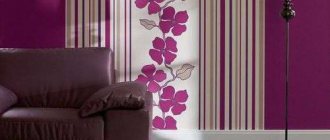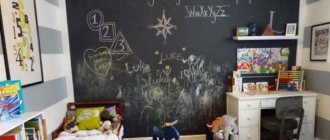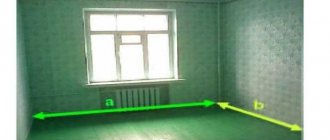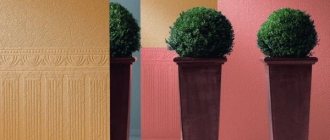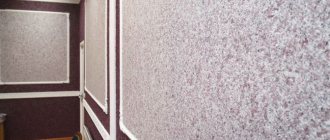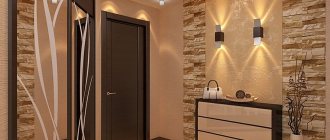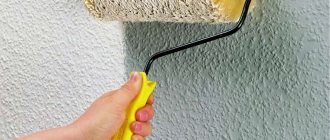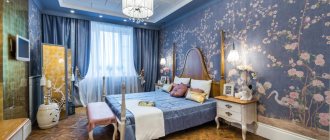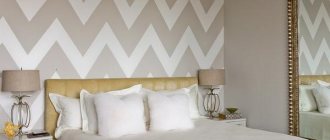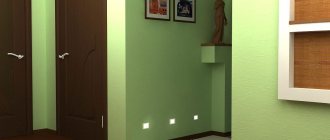MesterulManole
7049 0 0
MesterulManole January 12, 2018Specialization: many years of experience in finishing works of residential and office premises, dachas, country cottages, etc. Hobby: cycling in all its forms
A typical example of a narrow room, the disproportion of which is only enhanced by unprofessional design
From a design point of view, the rectangular shape of the room is inconvenient and that’s a fact. However, nothing prevents you from visually adjusting the features of the room. I'll talk about how to choose wallpaper for a long, narrow room and how to use these materials to visually improve a problem room. As a result, you can take the suggested tips and make your apartment more comfortable.
Types of bricks depending on material
So, before choosing this or that material as a stove lining, you need to understand what its varieties exist depending on certain characteristics.
This will make it clearer which brick products can be used when building a stove. Based on material, bricks are divided into two types:
- ceramic;
- silicate.
The first is made using firing methods based on clay mixtures, and the second consists of a mixture of sand and lime, as well as impurities. This material is made in an autoclave, and if one or another pigment is added to the mixture, it will acquire the desired shade.
When building stoves, it is recommended to use the first type - made of ceramics. This will be discussed further. Depending on the application, they are also divided into the following:
- ordinary solid brick - it is used for internal masonry;
- facing or finishing - such bricks are needed for finishing the finished masonry of an already completed building. Unlike the first one, it has a more uniform structure, looks more neat and has smooth edges.
Ideas for a wooden house
Small country houses and cottages often have low ceilings - this is a necessity, since fewer resources are spent on heating. Therefore, the task of visually increasing space is especially relevant here.
Most of the techniques described above are suitable for wooden houses, but a number of other nuances are also taken into account:
- For finishing, use light-colored wood - this will expand the space. Dark shades steal a few centimeters and make the room cramped and uncomfortable.
- Accessories must match the color of the walls. Wooden furniture of the same shade is most appropriate.
- The walls, in turn, are covered with a slightly darker varnish or wax than the ceiling, so that against their background it appears lighter.
- Coffered ceilings are often installed in a wooden house. This is a volumetric finish made of perpendicularly located beams that form cells. The beams are painted a darker color or made lighter in comparison with the base. Due to the contrast, it is possible to visually increase the height of the ceiling.
There are also more radical methods that require certain skills in the construction and repair of such buildings. For example, you can lower the floor. They do this as follows:
- Remove the floor covering.
- Remove old logs. The part may extend into the area of another room, so maximum care is needed.
- The holes formed in the walls are sealed with mortar.
- Cut holes for new logs so that they are lower than the previous ones by a maximum of 25 cm. Install the parts.
- If necessary, insulate the floor. Then the rough coating is laid, then the finishing coating.
Another way is to change the headliner. This option is suitable if the load-bearing beam system is hidden under the finishing material. In this case, the old coating is dismantled and a new one is installed just above the beams. The process consists of the following steps:
- Remove the old finish and dismantle the sheathing.
- Damaged ceiling beams are restored or replaced. The structure is treated with impregnations against fungi, rot and pests. Surfaces are opened with varnish, wax or paint.
- The space between the beams is finished with wooden lining or other decorative materials. First, a layer of thermal insulation is attached to the roof truss structure, on top of which a new ceiling is hemmed.
Color influence
According to professional designers, the right shade can give a room spaciousness. For this technique to be successful, you must combine the color of the walls with the overall color of the room - you cannot combine too different, flashy shades. Both the walls, the ceiling, and the floor should be selected in the same color scheme. This also applies to interior items, including curtains and furniture.
The walls, ceiling and floor are chosen in the same color scheme
Well-known fact: Different colors not only have an impact on a person, but also have their own special purpose. Shades such as peach, yellow or beige will help add coziness and warmth to the room. Most often, such wallpaper is used in living rooms, since this is where most of the time is spent. A sunny environment will help drive away fatigue and depression.
When choosing your color, you should remember that dark variations will not help solve the issue of visual expansion, but quite the opposite - saturation will take away some of the light, and therefore space.
For a bedroom or children's room, it is better to choose relaxing, soothing motifs. Light pink, blue, and light green colors cope well with this task. Don’t forget about white, an ideal and pleasing color to the eye.
Girl's room in light pink colors
There is a concept of dividing colors into two groups: warm and cold. Warm ones will stimulate a good mood and increased energy. These include red, orange, yellow - it is strictly forbidden to use them in a narrow room. But cold, soothing, harmony-giving blues, whites, greens and light greens will help expand the room. You should not use too bright, saturated colors.
It should be noted that the use of light colors will help in a room with an area of more than eight square meters. If the room is smaller, then if you use too light, cold tones, it will begin to resemble a hospital ward or public toilet. In this case, it is better to use other optical techniques: installing a fresco or photo wallpaper, laying mosaics in light, cool tones. For example, a blue color will help create the effect of moving objects away, which means it will visually expand the space
But warm orange, on the contrary, focuses attention on objects, which means it will make the room look narrower.
Living room interior 7 sq.m.
For cold, north-facing rooms, you can use patterns of warm colors and the same texture - this will help make the pattern voluminous and soft. Gold, yellow or orange colors will help create an atmosphere of warmth and comfort. Also, peach and beige will be a great addition to the overall look.
Warm colors will create a warm atmosphere
Don't want to use color schemes? Play with contrast - install a fresco on one wall, made in the same colors as all the walls. But the image should be one tone higher, that is, lighter.
Color
To make a narrow long room brighter, you can try to implement the following design technique. The walls of the room are divided into three parts, light canvases are glued to the uppermost part, and dark wallpaper with a deep color is glued to the remaining two lower parts. Moreover, the smaller the room, the stronger the contrast should be. It is permissible to choose wallpaper with a pattern, of course, small and not large.
There are other useful tips that may be useful to you:
- The meaning of color is very strong and should not be neglected. An example of this can be simple and banal: if you paint a room blue, it will be cold, and if you paint it orange, it will be warm. If you don't believe me, you can try it in your home.
- Red color is irritating and tense, but green, on the contrary, relaxes. Yellow adds positivity to the room, while blue or white adds freshness.
- In rooms where there is little sunlight, it is advisable to use a warm color palette, such as yellow. In rooms where the sun comes regularly, blue and light blue, refreshing wallpaper will look good. Directed sunlight enhances the richness of colors, while diffused sunlight makes them dull.
- In order not to languish from the heat and heat in a room on the south side of the house, put wallpaper in it that can absorb light and make the room cooler. Blue, blue, and terracotta colors do an excellent job with this task.
- Rooms on the north side of the house are often cool, so you should use wallpaper to slightly warm up the room. This will require gold, yellow, beige color variations.
Article on the topic: String for curtains and string curtains: installation secrets and operating features
Bedroom in soft and warm colors
You may already know these rules and have applied them to create various decorative interiors in your home. Maybe you even used wallpaper borders as a non-standard and interesting move.
Borders are strips of wallpaper material 10-15 centimeters wide. They are glued horizontally or vertically, and are designed to add zest to the interior, hide gluing defects, zone the room, or adjust the idea of the space of the room.
Using wallpaper border is acceptable if you have high ceilings. The use of a border most often affects the height of the walls, and not for the better. This becomes especially noticeable when he separates two types of different wallpaper, both in color and pattern.
Interior of a tiny living room
Most preferred colors and designs
Many people have literally absorbed a simple truth with their mother’s milk: dark colors narrow and make you look slimmer, while light colors expand and make you look fuller. The rule has remained unchanged to this day.
To visually change the size of a small room to a larger size, here are the ones to choose:
- lactic;
- beige;
- apricot;
- cream;
- caramel;
- golden;
- green;
- blue;
- pink;
- grey;
- silver color.
All colors chosen for a modest-sized room should be warm. Cool shades will further narrow already small rooms (how to choose the right wallpaper color?).
In addition, you should not be afraid to use wallpaper with patterns (read about how to adjust wallpaper to a pattern here, and from this article you will learn how to properly and economically glue wallpaper with a pattern). After all, without them, firstly, it is impossible to create such design styles as Provence, modern or classic. And, secondly, correctly, well-chosen prints help to achieve the desired effect faster.
The following have “expanding” properties:
- medium-sized stripes;
- large, single arranged flowers;
- small patterns on a contrasting background;
- geometric shapes located separately from each other.
Combining photo wallpaper with plain canvases or intersecting a bright bottom with a muted top on one wall will help expand the space of a child’s bedroom (find out how to choose the right photo wallpaper, glue it, and also make a picture out of it).
Some tricks for demarcating a small space
You should not ignore the redevelopment of a small apartment into a studio; this option will significantly add space to the room, despite the fact that it will have to be divided into zones.
Mirror. The long-known method of increasing space with the help of mirrors is used by many modern designers. To give the room a regular, square shape, you should mount a reflective surface on one of the long walls. A mirror originating from the floor or a reflective ceiling is a good way to adjust the volume of meters.
Furniture in small rooms should be only the most necessary, so as not to overload the space; it is best if it is multifunctional. If you plan to place objects along the wall, then the same color as the vertical surface will help smooth out the narrow room. Placing low furniture will create the illusion of high ceilings.
Decor
The use of a bright, single decorative element, a vase, a figurine or something else on a light background will draw attention to the object, thereby distracting it from the space.
Doors. By choosing ceiling doors for your home, you can significantly extend it.
Carpets
A large carpet on the floor, unfortunately, will not add visual meters, but rectangular and medium-sized specimens will be appropriate. Animal skins with uneven edges will help give the room the correct shape.
It is not recommended to place large indoor plants in small-sized housing, and also to clutter it with a large number of trinkets.
By following the rules described above and using some tricks, you can not only adjust any shape of the room, but also make even the smallest room comfortable for living.
Conclusion
Correct use of wallpaper will significantly change the visual perception of a narrow room. Moreover, in some cases, the result can exceed all expectations, for example, photo wallpaper can have an even greater expansion effect than even mirrors (see also the article “Wallpaper for uneven walls: features of selection and installation”).
Therefore, based on the above rules and experimenting with design, you can forget about such a problem as the visual unattractiveness of narrow rooms in the apartment. For more information on this topic, watch the video in this article.
The role of proper lighting and floor finishing
The visual perception of a room depends on the size of the windows. The more natural light there is, the more spacious the room appears. Small windows should not be covered with dark textiles; blinds, Roman or light air curtains would be appropriate. If it is possible to make windows without partitions, then you should take advantage of it. Solid glass completely changes the perception of a room.
How to visually enlarge a room when finishing a floor? It is necessary to use a uniform coating or with longitudinal stripes across the width of the room. Various diamonds, squares and other decorations on the floor visually reduce the space. A multi-colored carpet is also not welcome, as the texture of the floor will create a squeezing effect.
Any other coatings should be chosen without obvious patterns; it is recommended to pay special attention to shiny elements. It’s good if the doors and frames don’t stand out too much, but match the shade of the walls
What furniture to use to visually enlarge the room
Logic dictates the use of multifunctional furniture in small spaces - furniture that takes up minimal space when folded. Such furniture includes a sofa bed, a chair bed, all kinds of built-in beds, tables, and wardrobes. All of them save valuable square meters, while delivering a minimum of discomfort to household members.
If we talk about dimensions, then there is no need to choose bulky sofas, cabinets and tables. It is better to give preference to neat models made from light and weightless materials, such as rattan and glass. But even a classic sofa will fit well into a small room if you choose the right size. Use your imagination and calculate different options, the main thing is to respect the proportions of the room and furniture.
Upholstered furniture should not be too “lush” or voluminous. It is better to adhere to its strict forms.
What furniture visually expands the space
What furniture to choose for a small living room
Furniture for a small apartment
Furniture for a small bedroom
How to visually enlarge a room photo
Choosing wallpaper for a small room: wallpaper with a pattern
Of course, light and plain wallpaper will greatly visually expand the space of the room, but at the same time give it a very boring and conservative look.
The use of patterns and ornaments on wallpaper will add a more colorful and positive mood to the interior, but not all of them are suitable for small rooms.
For a small room, photo wallpaper is not the best option: in extreme cases, it is permissible to hang photo wallpaper with a small pattern
How to choose patterned wallpaper for small rooms:
- Firstly, wallpaper with a small, non-contrasting pattern can completely replace plain wallpaper, while a large pattern, even with a slight contrast, can significantly spoil the decision to visually increase the volume of the room. The correct option for using wallpaper with a large pattern in a non-contrasting color would be to paste it on one wall of the room, against which low furniture such as a sofa or bed is placed. For example, using wallpaper with a floral print will look spectacular in the bedroom at the head of the bed.
- Secondly, for small rooms, wallpaper with a rare contrasting pattern of small or medium size is suitable, which will enliven the interior of the room and will not reduce the space. For example, in children's bedrooms, wallpaper with small images of cars for boys, or characters from the animated series “My Little Pony” for girls will look effective. But you should completely abandon the use of large contrasting patterns on wallpaper, as they can eat up a large volume of the room.
- Thirdly, you should not consider decorating small rooms with wallpaper with high contrast and pattern density. Even a room with a small amount of furniture will visually seem too cluttered and uncomfortable. Therefore, you should either completely abandon this type of wallpaper. or allocate only one wall of the room for them.
Concluding our discussion about the use of wallpaper from drawings to decorate small rooms, it is worth mentioning once again that it is worth focusing on light shades of color, which visually increase the space of small rooms.
Wallpaper options for a narrow room
General rules
There are several effective techniques that will always help expand the room:
- Using a coating of a more saturated color on short walls than on long ones . You can also use tone-on-tone materials, but on short walls use a coating with a pronounced pattern. This technique allows you to make the desired accent, and thereby slightly hide the lack of space.
- Another very effective technique is the use of photo wallpaper . Moreover, they can be used to cover any wall of the room, the main thing is to choose the right image. So narrow photo wallpaper on the wall should have a picture with limited space.
If you decide to decorate a wide wall in this way, then the image, on the contrary, should be in perspective. For example, a canyon or plain expands the room horizontally. Accordingly, such photo wallpapers well level out the disproportionality of the room.
- The classic technique is to cover a long wall with a material with a vertical pattern . You can even use fabrics with solid stripes. For a short wall, canvases with horizontal stripes are suitable.
Option to expand space with photo wallpaper
Advice! A short wall can be decorated with drapery, curtains or drapes. This will visually hide the lack of space due to the large thickness of the folds.
Corridor
For a narrow corridor, it is advisable to use light wallpaper with a vertical image. In this case, you should avoid using gray materials.
Also, when deciding what wallpaper to choose for a narrow corridor, you can opt for photo wallpaper, which, as in other rooms, will help correct the situation with the disproportion of the room. However, in this case, proper lighting should be provided.
Corridor design option
Advice! The long corridor can be divided into zones. This will not be difficult to do with the help of wallpaper with different patterns, and arches made with your own hands from plasterboard.
Hallway
Often, apartment owners puzzle over what wallpaper to choose for a narrow hallway? The best option in this case is to decorate the room in contrasting colors.
For the lower part of the hallway, you can use dark-colored material, and for the upper part, light-colored material. You can connect the canvases harmoniously using a panel glued along the joint.
Advice! To expand the hallway, you can hang a large mirror on a long wall.
Bedroom wall decoration
Bedroom
When choosing wallpaper for a narrow bedroom, you can be guided by almost all the general rules given above.
In addition, some other design techniques will help solve the problem:
- It is advisable to cover the two long walls of the room with wallpaper with a large pattern, and the narrow walls with canvases with small patterns.
- Finish colors should be pastel tones.
For example, you can use the following colors:
- beige;
- peach;
- lime;
- baby blue.
It should be borne in mind that you cannot create contrast, as this will narrow the room even more, and you cannot use very bright and dark colors.
Advice! It is best to give preference to wallpaper with geometric patterns, which best hide the disproportion of the room.
Living room
The instructions for decorating the walls of the living room are the same as for the bedroom. In particular, one of the best options is to use photo wallpaper.
You can also pay attention to the drawing in the op art style, in this case it consists of lines that change the shape of space as a result of optical illusions. True, such a solution will not look good in every interior. In addition, such wallpapers are quite rare on sale, and their price is quite high.
Wall decorated in op art style
Of course, you should avoid paintings in dark and very bright colors. However, you can make bright accents, for example, highlight the middle of the wall with printed wallpaper.
Here, perhaps, are all the moments of expanding space through wallpaper. The rest depends on the interior itself.
In particular, do not forget that the best “friend” for visually increasing the volume of a room is light. Therefore, it is necessary to pay no less attention to the lighting of the room than to the design of the decoration.
How to visually enlarge a room with wallpaper
Choosing a suitable finishing material for the walls will help not only to zone the room if necessary, but also to blur its boundaries.
A wallpaper pattern with vertical stripes is suitable for low ceiling rooms.
Horizontal lines, on the contrary, will elongate the room in length.
Large decor, in the form of a panel or painting, placed on the far wall of a narrow room will attract attention. It is better to make the remaining walls in a neutral color, this way you can partially erase the boundaries of a narrow room.
How to visually expand a narrow room
- The pop art style applied to a small room will add additional meters to it due to optical illusions created by bright figures.
- Photo wallpaper on one wall in combination with a small pattern on the second will give the room uniqueness and delimit it a little.
How to use photo wallpaper to visually enlarge a room
- A 10–20 cm indentation of the wallpaper from the ceiling, if the height of the room allows, can adjust the size of the space.
- Photo wallpaper for the ceiling with a picture of the sky can make the room limitless.
- Combining wallpaper will be a good solution for a non-sunny and low room. To do this, use light wallpaper on top of the wall and dark wallpaper below.
- Wallpapering the ceiling by 15–25 cm will help increase the height of the apartment.
The most effective means for visual correction of a room
A bird's eye view of the city is a great room decoration that is guaranteed to expand a narrow wall
Someone is trying to improve the proportions of their home by arranging furniture in the right order with their own hands. Someone builds partitions, creating two nooks from one oblong room. Someone is trying to solve the problem with the placement of lighting fixtures. Meanwhile, the instructions for solving the problem are simple: you need to cover the interior with correctly selected wallpaper.
Popular techniques for visual correction of problem areas
| Illustrations | Description |
| 1. Long light walls combined with dark curtains . A dark curtain visually moves the distant part of the room closer to us, while lighter and less saturated walls narrow. | |
| 2. Decorative vertical insert . A vertical strip of wallpaper against a light background will divide the bedroom wall in half, making it visually shorter. | |
| 3. Full-wall mirror . A mirror makes a room many times wider; the main thing is to position the mirror correctly. | |
| 4. Vertical strip along a long wall . The vertical strip visually lengthens and narrows the wall | |
| 5. Long walls are light in color, and short walls are dark . This method is preferable when using plain wallpaper or coverings with small, frequently repeating patterns. As shown in the photo, a light monochromatic surface can be diluted with a painting or colored panel. |
Wallpaper that is guaranteed to expand space
| Illustrations | Description |
| 3D wallpaper with a large repeating symmetrical pattern . The photo shows a typical example of wall design that will look wider, even though the ornament is vertically oriented. | |
| Stylized panorama of the city . Although the silhouettes of the skyscrapers are oriented vertically, the panorama depicts a hilly skyline that divides the image along the horizon into a white and a dark half. In fact, such wallpaper, despite the pronounced pattern, performs the same function as horizontal stripes on a narrow wall. | |
| Photo wallpaper with horizontal designs . A bridge, railway lines, transport interchanges and other horizontally oriented structures on photo wallpapers will not only make a narrow room visually more spacious, but will also fit perfectly into the design of a modern interior. | |
| Panorama of snowy forest . This is a win-win option, since the snow-covered spruce trees contrast with the snow at the bottom and the sky at the top. That is, such a panorama will work similarly to wallpaper with a wide horizontal stripe. | |
Alternating colored horizontal stripes. Perhaps this is the most effective solution if the wall needs to be made less narrow.
| |
| 3D wallpaper with geometric tapering in perspective . The photo shows an example of how the perspective narrows, while the foreground opposite expands and, along with it, the wall visually increases. | |
Forest thickets. A picket fence of trees, despite its vertical location, will make the wall wider.
|
What mistakes are made when decorating long rooms?
| Illustrations | Typical errors |
| The longitudinal stripe is not where it should be . Stripes run along the entire perimeter. The price of such a solution is the lengthening of an already narrow room. | |
| Longitudinal oriented wallpaper texture . The room in the photo looks cluttered. The feeling is due to the massive wardrobe and bamboo wallpaper, in which the straw is located horizontally. | |
| Longitudinal decorative strip . The room was visually expanded, but the strip mounted along the wall again lengthened the room, emphasizing its lack. | |
| Longitudinal pattern on a long wall . The longitudinal pattern, as shown in the photo, visually increases the surface in the longitudinal direction. Given the parameters of the room, completely different actions are required. | |
| Longitudinal cabinet furniture . A common mistake is to display furniture against the wall. This solution is suitable for ordinary non-extended rooms. | |
| Vertical stripe. In the photo, the vertical strip visually raises the ceiling, but at the same time the wall that needed to be expanded seems narrower. |
Basic rules for using photo wallpaper
There are a limitless number of photo wallpapers on the market, but not all of them are able to expand the space. Moreover, even those that work well to increase space in one room will be completely useless in another room. Each room requires an individual approach, and the smaller it is, the more carefully you need to approach the choice. For example, a photo wallpaper with a large flower on the wall of a tiny room will play a cruel joke - the room will only seem smaller.
So what kind of wallpaper can really expand the space in a small room? Designers advise considering the following rules when choosing:
- The main task of all techniques aimed at expanding space is to erase boundaries or move them, as it were, outside the premises. For these purposes, panels with perspective work best, incl. those with a horizon line;
- Light shades expand the space well, while dark shades do the opposite. This is a fundamental rule that almost everyone knows and uses;
- if it is necessary to extend the room in height, then use photo wallpaper with vertical stripes, but you should not take this information literally, because vertical stripes can be tree trunks or skyscrapers in the image of megacities. To visually expand the room in width, use wallpaper with horizontal stripes, which work well with horizon lines in landscape images;
- The texture of photo wallpaper is also important, since smooth glossy canvases, due to their reflective properties, although slightly, expand the space of the room;
- Separately, it is worth noting 3D photo wallpapers, which, due to a special printing technology and the correct choice of colors, appear three-dimensional. They expand the space well, which will be discussed below, but in especially small rooms you need to be extremely careful, since the 3D effect can only be appreciated from a certain distance, and if there is not enough of it in the room, then the effect will be exactly the opposite - the image will be crushed and even irritate, and it will be difficult to find in such a room for a long time;
- In the desire to maximize the space, one must not overdo it. For example, a combination of photo wallpaper with perspective, multiple mirror and reflective surfaces, a mass of lamps is a direct path to creating a room where it will be impossible to spend time;
- Photo wallpaper that expands the space is a fairly active element of the interior, so the remaining finishing elements should be calmer. This primarily concerns the flooring and the design of the remaining walls.
Difficulty of choice
The biggest problem of a narrow room is its disproportion. In such conditions, it is difficult to create comfortable living conditions and bring coziness without obvious efforts. However, using the experience of designers when choosing wallpaper, you can correct the narrow theme of the room, veil small sizes and give the room an original look.
The basis for choosing wallpaper for any room, narrow or wide, short or long, is, of course, the selection of a color palette. The correct choice of colors will allow you to create the desired atmosphere in the room, disguise its shortcomings, present it from an advantageous angle, expand or narrow it as necessary. It is through the play of colors that we will adjust the visual space.
In our case, it is best to use a simple and banal technique, choose bright and light wallpaper of the same tone. Glue bright canvases on a narrow wall, and light ones on a long one. With the help of this alternation of wallpaper, we reduce the length of a narrow room, making it more proportional.
Choosing a pattern is not an easy task, but in small rooms, you should always stick to medium and small sized ornaments so that they do not overwhelm you with their color.
Room with original geometry
A full-fledged small-sized ornament, repeated on the wallpaper, allows you to expand the boundaries of space, it seems to blur them. Geometric patterns look great on wallpaper; for example, rhombuses can expand the space.
Related article: Do-it-yourself adjustment of the volume of the flush cistern
In order to correctly adjust the visual perception of a room, it is advisable to clarify its dimensions, and build your strategy from this. For example, if the height is not enough, we can always place wallpaper in the room with a vertical stripe, and if the width is not enough, we can always place wallpaper with a horizontal stripe.
The use of striped wallpaper is the oldest design technique. Its subtlety lies in the fact that the narrower the stripes, the better they work, the more they increase the desired perception of space.
If, in order to create harmonious proportions, it is necessary to reduce the height of the ceiling, make it more massive and heavy, then choose checkered wallpaper for it.
A chaotic pattern on the wallpaper allows you to hide the unevenness of the wall, while monochromatic solutions will help to emphasize the ideality of the surface. When you cover the walls of a room with wallpaper with a chaotic pattern, sometimes it begins to seem that a similar plot is going on inside the body.
Contrasting interior of a small living room
With a fuzzy pattern on the wallpaper, you don’t have to bother choosing interior items and furniture, but not all furniture and decorative gadgets are suitable for a clear pattern.
If you don’t like drawings, then just stick to a light color palette. All light colors are ready to expand the space of the room, so in the wallpaper store there are a dime a dozen options with such colors.
Color spectrum
Colors evoke different sensations, and each of them has its own purpose. You can visually enlarge a room with wallpaper. The main thing is to choose them wisely. Warm shades - yellow, beige, peach - give a unique coziness. This wallpaper is perfect for the living room. Bright rich colors drive away depression, fatigue, and charge you with energy. It should be remembered that if the question is how to visually enlarge a room, then it is necessary to avoid too saturated and dark colors - they “take away” space and light. Delicate pastel colors of pink, pale green, light blue are calming and relaxing, so they will be an excellent option for a bedroom or nursery.
Let's sum it up
Now you know how to expand a narrow room with wallpaper. If you have any questions about the choice of finishing materials, write about it in the comments. Also, watch the video in this article.
Did you like the article? Subscribe to our Yandex.Zen channel
January 12, 2021
Room design,Wallpaper
If you want to express gratitude, add a clarification or objection, or ask the author something, add a comment or say thank you!
Volume and proportions are at the mercy of color and graphics
How can you influence the perception of the interior using special wall decoration techniques, and what wallpaper for a narrow room is of interest?
The following methods of decorating walls harmonize the space and make the interior memorable:
- Sticker of white frieze under the ceiling.
- White ceiling, light floor and light wallpaper on long walls. For short walls, choose wallpaper in dark or rich, bright colors.
- Covering long walls with panels with vertical or square panels.
- Dividing a room into zones and covering them with different wallpapers from the same collection.
- Accent panels the full height of a long wall.
Accent wall in a narrow living room
- Playing with graphic designs - stripes, diagonals, diamonds, lattices, dark or contrasting patterns.
- Using photo wallpaper in a narrow room - the photo shows examples of pasting for a short and long wall.
Light wallpaper in a narrow room visually expands the space
General information
A living room or bedroom may have this disadvantage, however, in this case the term “narrow room” is relative. It would be more correct to say - a room with an unfavorable ratio of length and width.
The most “narrowed” ones, most often, are the corridors. But even they can be made more attractive. Of course, the traditional solution in the form of plain wallpaper is not suitable in this case, since the “carriage” effect will be felt.
Therefore, such premises require a special approach. In particular, the use of various color effects and the correct selection of patterns will help to “push apart” the walls.
In the photo - photo wallpaper in the interior of a narrow room
Optical effect
Light objects appear larger, which is why designers use this technique when decorating interiors. Light decoration visually expands the space - just use a cool pastel color or white color on the walls.
You should also choose furniture in light colors, while the walls, ceiling and floor should be slightly different in tone.
Wall decoration
Wallpaper is often used to decorate walls. This material provides a wide range of options for visually adjusting the room. Vertical stripes or patterns make the room visually taller, while horizontal stripes, on the contrary, help expand a small room.
You can correct the proportions of an elongated and narrow room by brightly decorating one of the walls. With the help of a small print or discreet ornament, the room will gain volume.
You should be careful when choosing a geometric pattern on your wallpaper. Depending on its color, scale or location on the canvas, the room as a whole is perceived differently.
Using a large drawing on one wall, make its plane closer
This technique is recommended for elongated narrow rooms, where it is important to reduce the length and visually increase the width of a small room
Photo wallpapers give an excellent effect. Therefore, when choosing them, you should take into account their ability to radically change the perception of the room. Thus, an image on a photo wallpaper stretching into the distance enlarges the room, while the lack of perspective, on the contrary, reduces it.
Ceiling decoration
Not only walls, but also the ceiling can help to enlarge a small room, creating the necessary space using stretched glossy fabric - this is the easiest way.
However, it is worth remembering that an almost mirror surface doubles the objects in the room, so this option is best suited for modern interiors in the spirit of minimalism.
To maintain the illusion of spaciousness, but not to overload the space, combined stretch ceilings with glossy and matte textures are used.
You can adjust the geometry of an elongated room with transverse polyurethane ceiling beams that contrast with the shade of the ceiling.
Stretch canvases with photo printing in the shape of the sky add volume to the room.
How to fix the low ceiling effect
To make a room appear taller, several methods are used. First: vertical stripes, drawings, patterns on wallpaper, made with paint or using hand-painting techniques.
High door and window openings, as well as straight cut plain curtains, help to visually make the walls taller.
Narrow vertical mirror inserts on the walls will not only increase their height, but also expand the space.
Floor decoration
For small rooms, it is recommended to choose plain light shades of flooring materials. To make the room look more spacious, you can focus on the layout of the laminate - diagonally or herringbone.
What furniture to use to visually enlarge the room
Logic dictates the use of multifunctional furniture in small spaces - furniture that takes up minimal space when folded. Such furniture includes a sofa bed, a chair bed, all kinds of built-in beds, tables, and wardrobes. All of them save valuable square meters, while delivering a minimum of discomfort to household members.
If we talk about dimensions, then there is no need to choose bulky sofas, cabinets and tables. It is better to give preference to neat models made from light and weightless materials, such as rattan and glass. But even a classic sofa will fit well into a small room if you choose the right size. Use your imagination and calculate different options, the main thing is to respect the proportions of the room and furniture.
Upholstered furniture should not be too “lush” or voluminous. It is better to adhere to its strict forms.
What furniture visually expands the space
What furniture to choose for a small living room
Furniture for a small apartment
Furniture for a small bedroom
How to visually enlarge a room photo
Raising the ceiling
Taller and longer
It seems that in a room with high ceilings you can even breathe easier, and achieving this effect is not so difficult. The most obvious trick is to stick wallpaper with a vertical pattern on the walls. It is better for the pattern to be discreet, but only a small area can be highlighted with bright stripes or an active pattern. Narrow cabinets and shelves, long vases, wall mirrors and paintings in high frames also visually raise the ceiling. And it’s better to hang them a little higher than usual.
It seems that in a room with high ceilings you can even breathe easier, and achieving this effect is not so difficult.
Game of color and light
To create the effect of a high ceiling, its lighting is of great importance. You need to choose a small chandelier or lamp with beams of light directed vertically upward. But you shouldn’t use wide curtain rods - they visually make the ceiling line lower. It makes more sense to make a hidden cornice and hang plain curtains that reach the length of the floor.
Cold and light shades visually increase the height of the ceiling. You can also paint the ceiling and walls the same color, but make the ceiling a little lighter in tone. Gloss paint creates a more pronounced height effect than matte paint.
Size matters
If the furniture in the room is quite low, then the ceiling seems visually higher
Bright carpets on the floor have the same effect: they attract attention and create the illusion of high ceilings in the room
How to “raise” low ceilings?
The exact opposite problem is how to visually increase the height of the ceiling
. This is where wallpaper with a vertical pattern will come to the rescue. They will stretch the walls upward, making the room seem more spacious.
Curbs for walls lower ceilings. Don't use them if you want to make the room look upward.
An original idea is to put photo wallpaper with a picture of the sky on the ceiling. Such a pattern will create the illusion of infinity, due to which the room will seem more voluminous.
Pushing the walls apart
Color and light
As you know, light colors make an object visually larger, while dark colors visually make it smaller. In small rooms, it is better to use light shades for walls and furniture, and so that they do not merge with each other, you can take colors that differ in tone and color scheme. Strong contrasts, flashy colors, bright spots eat up part of the space, so it is better to focus on pastel neutral shades and cool tones that expand the space.
The brighter the room, the larger it seems. Therefore, to let in as much natural light as possible through the windows, hang light curtains and airy curtains on them, and also clear the window sill from large indoor plants.
Wall decoration
In small rooms it is not recommended to use wallpaper with large contrasting patterns; you should also avoid patterns that are too small - they can ripple in the eyes. In this case, you can cover one of the walls with wallpaper with a contrasting geometric pattern, and leave the other three in a neutral color scheme. Thanks to this technique, the room will be perceived wider than it actually is.
In this case, it is important to remember that a vertical pattern makes the room appear taller, while a horizontal pattern lowers and expands the space
Photo wallpaper pasted on one of the walls also visually expands the boundaries of the room. The greatest effect is obtained by depicting a landscape in perspective: the horizon of a field or sea, mountain peaks or forest edge, a view of a city at night.
The right furniture
To make a room seem larger, you need to leave as much free space in it as possible. All sorts of folding sofa beds, tables, built-in wardrobes and shelving will help with this. The furniture should be small-sized, with strict, laconic forms, and it is better to place it along the walls or in the corners, so as not to visually divide an already small room into parts.
Minimalist style, laconicism in decoration and furniture, lack of open shelves, a single color scheme with several accents - all this makes the space of the room unified and voluminous
All kinds of figurines, candlesticks, photographs in frames, small paintings distract attention and cause a feeling of clutter. It is better to replace several small paintings with one medium-sized one, and free open shelves from unnecessary decor
The power of glass and mirrors
It's no secret that mirrors are the best helpers in expanding space. The room reflected in the large wall mirror appears twice as large. It is better to hang it on a long wall so that, when reflected, the room does not become even longer, but turns into a square.
Furniture with glass surfaces also visually expands the space and makes massive objects weightless. Tables with glass tops, a cabinet with translucent inserts on the doors, stained glass windows, glass lamps - they all seem to dissolve into the interior and become less noticeable to the eye.
Furniture with glass surfaces also visually expands the space and makes massive objects weightless.
Flooring
The color and structure of the floor also matters for the perception of the size of the room: it is also better to use light colors for it. Parquet or laminate laid diagonally not only visually increases the area of the room, but also hides the irregular geometry of the walls.
There is another clever trick that helps to visually enlarge a room. You need to place a beautiful bright object - a flower, figurine or vase - in the farthest corner of the room
Guests' attention will immediately fall on this item, and they will have a feeling of greater perspective
Methods for expanding space using wallpaper
To make a room visually larger, you can use the right combination of ordinary wallpaper. This is the most budget-friendly and effective option; you just need to follow these rules:
- Canvases should not be full of large patterns and designs. And small details on the walls are designed to visually expand the space. A small floral pattern in a country style can be supported by matching curtains.
- Vertical stripes on the walls increase the height, but reduce the volume of the home.
- To balance out long, narrow walls, use canvas with a horizontal pattern, or wallpaper the far wall in warm, dark tones.
- Combine canvases of different colors. Just remember that the upper part of the walls needs to be made lighter and the lower part darker.
- The ideal combination is simple and functional furniture with plain light walls.
- Opposite walls in a long room can be played with contrast: cover one wall with wallpaper with a small pattern, and the other with a large one.
- Light wallpaper with darker vertical stripes will help make the room taller.
Decorative techniques
When choosing a finishing material for walls, pay attention to its texture. In accordance with the designer’s idea, you can choose canvases to match stone, leather, plaster, textiles, wood, frescoes and other options. At the same time, do not forget that for the hallway you need to choose easy-to-care materials.
To create an unusual, original atmosphere in your corridor, you can use various techniques:
Combination
You can put dark wallpaper on the lower half of the wall, and lighter wallpaper on the upper half. They will add light and make the corridor visually wider, and the dark bottom will be a barrier to soiling the wall.
When decorating with combined wallpaper, you need to carefully select shades so that they combine well. For example, you can cover part of the wall near the floor with a canvas with a vertical pattern, and above it with plain or finely patterned wallpaper. The combination of these types of wallpaper is made with a baguette selected in accordance with the design of the entire room.
To attract attention to the design on the canvas, you can use various moldings, panels and appliqués. This way you can create an individual, unique design in your hallway.
If you have a long and narrow corridor, different wallpapers on opposite walls will look beautiful, as long as the combination of color and pattern is observed.
For example, on one wall there will be wallpaper in the form of a floral pattern on a greenish background, and on the other there will be a canvas with vertical beige stripes. You can visually expand the room with this finishing option.
If in a long corridor the wall near the entrance is covered with darker wallpaper with an ornament, the opposite wall with lighter wallpaper, and at the junction you build an arch or trim it with panels, then such a corridor will look shorter. This way you can get two different functional zones.
You can combine finishing materials of different colors like this - decorate the entrance area using a dark color, and then lighten it using a gradient and make a gradual transition, for example, from dark green to light green.
Photo wallpaper
It is best to place photo wallpaper on the walls of the corridor farthest from the entrance. If they are made in warm shades, then the space will seem shifted, and if in cold shades, then the space will have a panoramic view.
If you frame a small photo wallpaper on one side of the corridor, you can get a picture. If this picture depicts a landscape with a long real perspective, then it will visually deepen the space and will be an excellent decoration for the interior of the room.
If there is a storage room in a narrow corridor, then it is better to remove the door to it and make an opening in the form of an arch. By decorating the opening with suitable wallpaper, you can visually expand the space.
Another way to expand the corridor is to use mirrors . In long rooms you can use fairly large mirrors, and in shorter rooms you can use several small ones, giving the illusion of an unusual space.
The right wallpaper will help transform your narrow hallway into a wider space and make it a cozier, brighter and more beautiful space.
When decorating a corridor or hallway, remember that they are part of your apartment and should not stand out from the overall stylistic decision. If all these rules are followed, the corridor will give the owners comfort and aesthetic pleasure, and guests will have warm memories from visiting your home.
